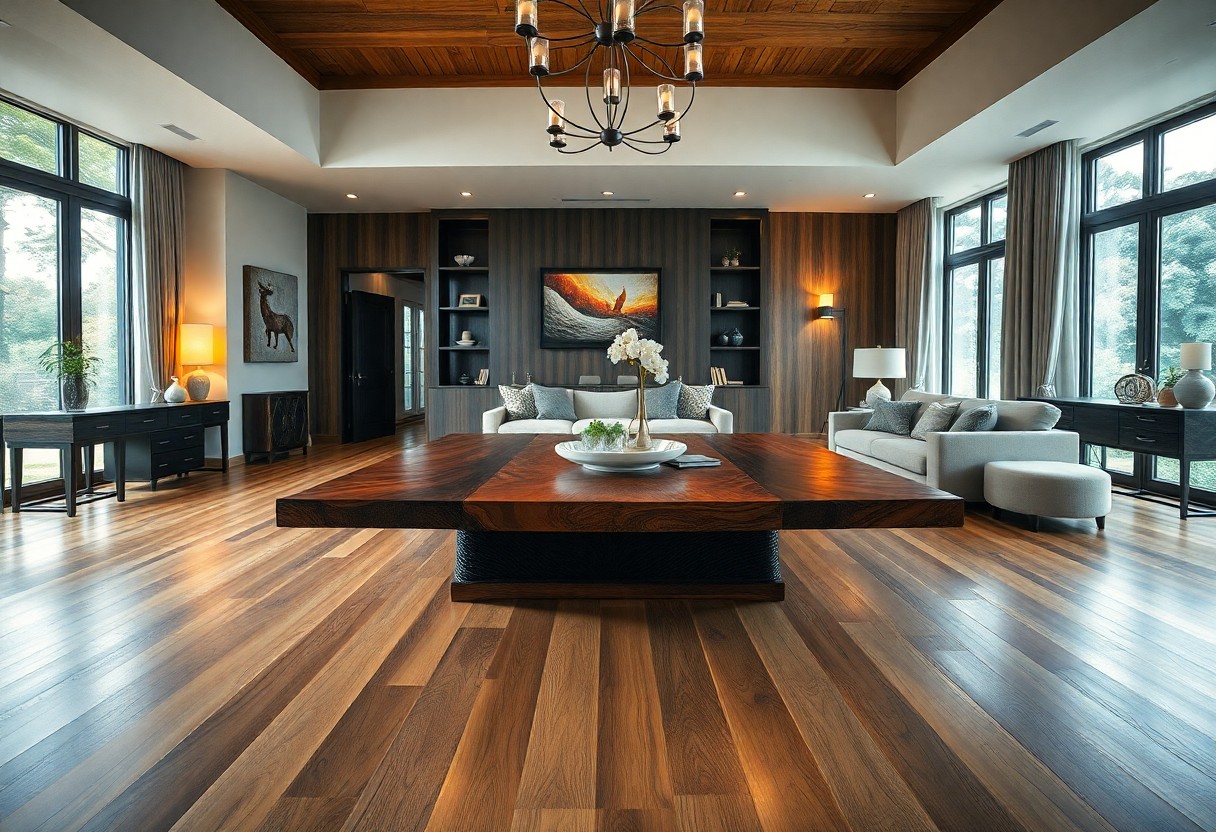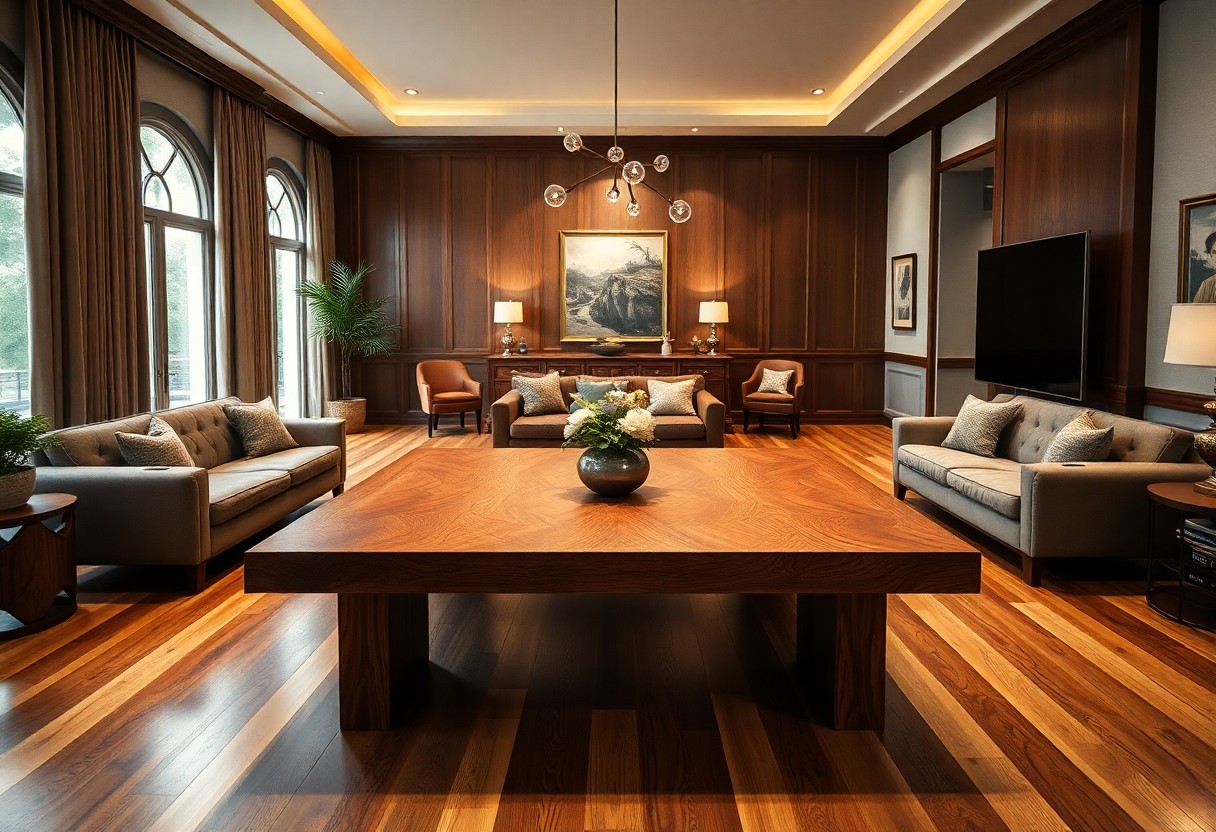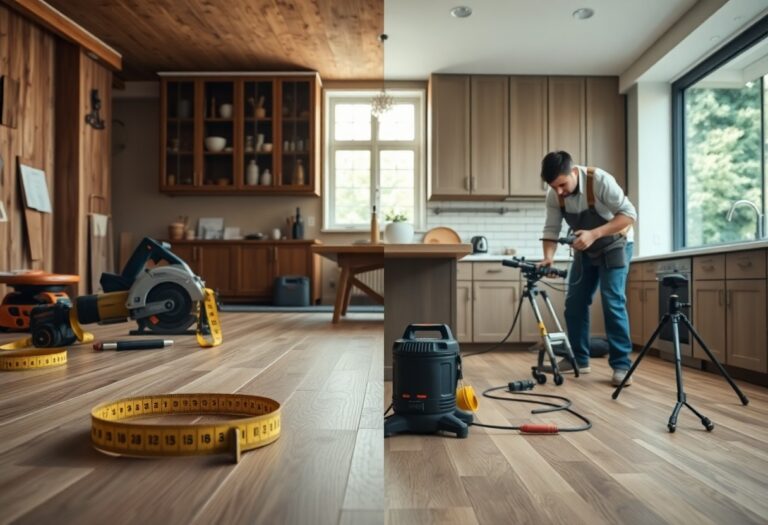Guide yourself through the process of selecting the ideal hardwood giant for your home, ensuring you make an informed choice that enhances both aesthetics and functionality. Whether you’re seeking a stunning centerpiece or durable flooring, the right hardwood can transform your space. This comprehensive guide will walk you through key factors like wood species, finish options, and maintenance considerations, empowering you to create a warm and inviting atmosphere tailored to your preferences. Dive into your journey of finding the perfect hardwood that meets your style and lifestyle needs.

Understanding Hardwood Giants
The world of hardwood giants is vast and varied, offering you a plethora of options when choosing the perfect flooring or furniture for your space. Understanding what defines hardwood giants will help you make informed decisions that marry aesthetics with practicality. These larger tree species are characterized by their dense, durable wood, making them ideal for long-lasting structures and finishes. The benefits of hardwood giants not only include visual appeal but also resistance to wear and tear, ensuring your investments withstand the test of time.
Types of Hardwood Giants
An overview of different types of hardwood giants can guide you towards selecting the best fit for your home. Here’s a closer look at some prominent hardwood species, along with their unique features:
| Type | Features |
| Oak | Highly durable and attractive grain patterns. |
| Maple | Light in color and resistant to scratches, great for high-traffic areas. |
| Cherry | Rich color that darkens over time, offering a warm ambiance. |
| Walnut | Dark, rich color with a sophisticated appeal, often used in luxury furniture. |
| Birch | Light-colored and durable, ideal for contemporary designs. |
- Consider the look you want to achieve in your home.
Factors to Consider When Choosing
There’s a variety of factors you should assess before finalizing your choice of hardwood giant. You must take into account the wood’s hardness, maintenance needs, and how well it aligns with your overall interior design style. Different species offer varying levels of durability, aesthetic appeal, and cost, all of which should fit seamlessly into your lifestyle and the demands of your household. Below are some key considerations:
- Evaluate the hardness based on your activity level and furniture placement.
Choosing the right hardwood giant for your home means aligning practical features with your aesthetic vision. Look for a wood species that not only complements your interior design but also stands up to wear over time. Factors such as color variation, grain pattern, and finishing options can significantly impact the overall feel of a room.
- Assess the environmental impact if sustainability is important to you.

The Step-by-Step Guide to Selection
If you’re launching on the journey to select the perfect hardwood giant for your home, it’s vital to approach the process methodically. This decision encompasses various factors, ranging from aesthetic to practical considerations. To assist you in tackling this important selection, here’s a straightforward table highlighting key aspects to think about during your decision-making journey.
| Factors to Consider | Description |
|---|---|
| Room Size | Consider how the dimensions of your space complement the type of hardwood. |
| Color Scheme | Evaluate how different colors of wood match your existing décor. |
| Foot Traffic | Identify how much daily foot traffic the area will experience. |
| Lighting | Natural vs. artificial lighting can affect the appearance of wood. |
Assessing Your Space
Now that you’ve familiarized yourself with some of the key factors, it’s time to assess your space more thoroughly. Look around your home and identify which rooms will benefit most from hardwood flooring. Think about the size and layout of each room, as well as any architectural features that might influence your choice. For instance, larger rooms can handle wider plank widths, while smaller rooms may look better with narrower planks to create a sense of openness.
Additionally, keep in mind how the hardwood fits within the flow of your home. Open-concept spaces need seamless transitions between different flooring types, while rooms with more enclosed layouts may allow you to experiment with contrasting colors or textures. Assessing your space thoroughly ensures that the hardwood you choose will harmonize beautifully with your home’s overall aesthetic.
Evaluating Durability and Maintenance
While choosing the right hardwood involves aesthetic considerations, durability and maintenance should also play a significant role in your decision. Look for hardwood types that can withstand the demands of your household, considering factors such as whether you have pets or children. Some wood species are naturally more resilient to scratches and dents, which can greatly enhance the longevity of your flooring.
Additionally, a commitment to maintenance will help you make an informed decision. Certain woods may require regular treatments or refinishing, while others are designed for easier upkeep. Take the time to research specific wood finishes, as they can also impact the durability and maintenance effort required for your floors. Ensuring that your hardwood choice aligns with your lifestyle will lead to satisfying results.
Space considerations are vital when evaluating the durability of flooring materials. You’ll want to match your hardwood to the level of activity in each area of your home. For instance, high-traffic zones like hallways or living rooms should have more durable options, while spaces like bedrooms might allow for softer woods that enhance comfort. By balancing the characteristics of your chosen wood with its intended use, you can ensure you’re making a choice that meets both aesthetic and functional needs in your home.
Tips for Making the Right Choice
For anyone looking to enhance their home’s aesthetic, selecting the right hardwood giant is necessary. It’s important to consider several factors that can affect both the look and feel of your space. Start by evaluating your lifestyle and the level of traffic your floors will endure. This understanding will guide you towards a finish that suits your needs, whether you prefer a rustic charm or a more polished appearance. Here are some tips to keep in mind:
- Assess your budget and define how much you’re willing to invest.
- Think about the color palette of your home to ensure a good match.
- Consider the type of hardwood species that best suits your comfort and decor preferences.
- Factor in installation complexity, as some hardwoods require professional help.
- Research maintenance requirements since some hardwoods may need more attention than others.
Thou must weigh these elements carefully to make an informed decision that will complement your living space for years to come.
Sourcing Quality Materials
Making the decision to use hardwood can be a significant investment, and sourcing quality materials is a key step in the process. Look for reputable suppliers that provide certified and sustainably sourced wood. Ensuring that your hardwood is harvested responsibly not only maintains ecological balance but also guarantees that you receive a top-tier product. Check if the wood has undergone appropriate grading processes to reflect its durability and visual appeal.
Furthermore, don’t hesitate to ask about the origin of the hardwoods. Different regions produce distinct types of hardwoods each with their unique characteristics. Understanding where your materials come from can lead you to options that are more suited to your climate, improving the longevity of your flooring. Quality connections with suppliers can also offer you exclusive deals on premium products.
Expert Recommendations
One of the best strategies for selecting hardwood flooring is to seek out recommendations from interior designers or flooring specialists. Engaging with experts allows you to tap into their extensive knowledge and experience, which can help you avoid common pitfalls. They may suggest lesser-known species that are both durable and cost-effective, or share insights on trends that resonate with your design intentions.
Recommendations from professionals can provide you with detailed information about various hardwood options, including species characteristics, finish choices, and long-term maintenance requirements. Their insights will not only save you time but can also enhance your overall satisfaction with the final result. Always be open to expert guidance; leveraging their understanding will prepare you adequately for this significant home improvement choice.
Pros and Cons of Different Hardwoods
After evaluating the various hardwood options available, it’s crucial to weigh the pros and cons associated with each type. Different hardwoods come with their own unique characteristics, which can influence your choice based on your home’s needs. Below is a table summarizing the strengths and weaknesses of various hardwoods, helping you make an informed decision.
| Hardwood Type | Pros and Cons |
|---|---|
| Oak | Durable and long-lasting; can be quite heavy and may warp. |
| Maple | Hard and resistant to scratches; can darken over time. |
| Cherry | Beautiful rich color that deepens with age; softer, making it more prone to dents. |
| Hickory | Very strong and shock-resistant; heavy and can be challenging to work with. |
| Birch | Light color that can brighten a room; not the best for high-traffic areas. |
| Walnut | Luxurious look with rich tones; can be expensive and softer than some alternatives. |
| Teak | Highly resistant to moisture and insects; expensive and requires regular maintenance. |
| Mahogany | Rich color and high-quality finish; can be more susceptible to temperature changes. |
| Ash | Great elasticity and strength; tends to be more affordable but may not last as long as oak. |
| Poplar | Economical choice and easy to paint or stain; softer and less durable. |
Strengths of Various Types
You should consider the specific strengths of each hardwood type when making your final decision on flooring or furniture. Each wood offers distinct benefits that can enhance the aesthetics and functionality of your space. Below is a table that highlights the key strengths of some popular hardwoods.
| Hardwood Type | Strengths |
|---|---|
| Oak | Exceptional durability, versatile grain patterns. |
| Maple | Optimally hard, good for heavy foot traffic. |
| Cherry | Rich hues that develop character with age. |
| Hickory | One of the strongest hardwoods, excellent for endurance. |
| Walnut | Elegant and timeless beauty, widely sought after. |
- Consider grain patterns when selecting wood.
- Think about the overall aesthetic of your space.
- Evaluate the potential for wear and tear based on usage.
- Be aware of maintenance requirements for each type.
- This choice ultimately affects your home’s value.
Limitations and Considerations
Any selection of hardwood comes with its limitations, which you must examine before proceeding with your project. It’s critical to think about the intended use of the hardwood—whether it’s for flooring, cabinetry, or furniture—and how this use might affect its longevity and maintenance needs. Thus, some woods that are beautiful may not be practical for high-traffic areas.
Considerations such as the local climate, humidity, and even the presence of pets should factor into your choice. Each hardwood reacts differently based on these variables, which can affect how it performs over time. Furthermore, the cost can differ greatly depending on the type you choose, and some woods are considerably more expensive due to rarity or demand.
Installation and Care
Now that you’ve selected the perfect hardwood giant for your home, it’s time to focus on the installation and care to ensure that your new flooring lasts for years to come. The installation process is not just about laying down the planks; it involves preparing the space, acclimating the wood, and ensuring you have the right tools and techniques to create a sturdy, beautiful floor. Understanding what to expect during installation can help you achieve the best results and is just as important as the choice of hardwood itself.
Preparing for Installation
Now, before jumping into installation, assess your existing floor and determine if it requires removal or if you can install your hardwood directly over it. If you’re removing an old floor, ensure that the subfloor is clean, dry, and level. After this, let your hardwood acclimate in the room where it’ll be installed for at least 48 hours. This will help prevent any warping or shrinkage once the flooring is laid down. Additionally, having the right tools on hand—like a saw, nail gun, and measuring tape—will streamline the process and yield a professional finish.
Maintenance Tips for Longevity
One of the best ways to ensure the longevity of your hardwood flooring is through consistent maintenance and care. By creating a simple routine, you can protect your investment and keep your floors looking stunning. Regular cleaning, using appropriate products, and addressing spills immediately can go a long way. Here are several tips to maintain your beautiful floors:
- Use a soft-bristle broom or a vacuum with a hardwood attachment for regular cleaning.
- Wipe up spills promptly with a damp cloth to prevent moisture damage.
- Avoid excessive water and mop with a slightly damp cloth rather than soaking the floor.
- Place rugs in high-traffic areas to reduce wear and tear.
- Reapply finish as needed to protect the wood and enhance its appearance.
The key to maintaining your hardwood giant is to nurture it regularly, preventing problems before they start. Consistency in care ensures that your floors remain a beautiful focal point in your home.
Maintenance
Maintenance is a vital part of ensuring your hardwood flooring stays vibrant and strong over time. Investing in high-quality cleaning supplies specifically designed for hardwood can yield significant benefits, while avoiding harsh chemicals will help protect the wood’s finish. In addition to regular cleaning, consider educating yourself on refinishing techniques, which can restore the look of your hardwood without needing wholesale replacement. Follow these additional tips for upkeep:
- Adjust humidity levels in your home to prevent wood expansion or contraction.
- Avoid wearing shoes with hard soles on the floor to minimize scratches.
- Check and fix any furniture pads regularly to protect against gouging.
- Periodically check for signs of water damage or gaps between planks, addressing issues immediately.
- Schedule professional cleaning as needed to maintain the integrity of the finish.
The ongoing care of your hardwood flooring is an investment in its appearance and lifespan.
Common Mistakes to Avoid
All too often, homeowners rush into selecting a hardwood giant for their space without correctly assessing their needs, leading to dissatisfaction down the line. Misjudging your lifestyle, the function of the space, or even the specific characteristics of different hardwood types can lead to costly pitfalls. For instance, if you lead a busy life with kids or pets, opting for a softer wood that scratches easily might not be the best decision. Instead, you should evaluate your daily routines and how different wood selections will stand up to them. Consider factors such as maintenance, durability, and the overall design aesthetic you want to achieve in your home.
Misjudging Your Needs
Misjudging your needs can also extend to overlooking the climate you live in or not considering the natural light your home receives. Different hardwoods are more or less susceptible to warping, fading, or swelling based on humidity and temperature. By conducting research or consulting with experts, you can align your selection with the practical aspects of your environment as well as your lifestyle, ensuring that any investment you make stands the test of time.
Ignoring Environmental Impact
Clearly, making a sustainable choice is becoming increasingly important, and ignoring the environmental impact of your hardwood selection can have long-term effects. When you pick hardwood, consider sourcing options that utilize responsibly harvested materials or those that are certified by reputable organizations. Additionally, the production process of certain woods can heavily influence their ecological footprint, so being informed about these factors can contribute to a more sustainable choice in your own home.
The growing demand for sustainable practices in home renovation means you have the option to prioritize woods from certified sustainable forests or even consider alternative materials that still offer the aesthetic and durability you desire. Your choice not only impacts your home’s look and feel but also contributes to a larger conversation about environmental stewardship. By being mindful of the sourcing and production impact of your hardwood, you can make decisions that reflect your values and help protect our natural resources for future generations.
To Wrap Up
Considering all points, choosing the right hardwood giant for your home is a decision that should not be taken lightly. With a myriad of options in terms of wood species, colors, finishes, and sizes, it’s imperative that you evaluate what best fits not just your aesthetic preferences but also your lifestyle and practical needs. Assessing factors such as durability, maintenance requirements, and the amount of foot traffic your flooring will endure will guide you towards the best hardwood option for your space. It’s advisable to collect samples and visually inspect them in your home’s lighting to ensure that the grain and hue align with your expectations.
Your choice of hardwood giant will have lasting impacts on the ambiance and value of your home. Taking the time to educate yourself on the different varieties allows you to make an informed decision that complements your décor while offering the functionality you desire. As you launch on this journey, consider consulting with professionals in the industry who can provide tailored recommendations based on your specific circumstances. By being proactive and thorough in your selection process, you’ll ensure that your final choice is one that enhances your living experience for years to come.





